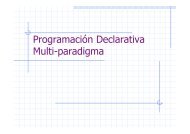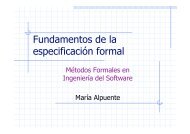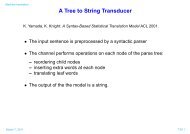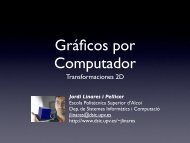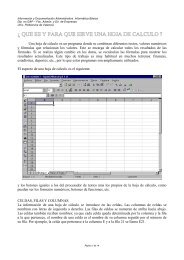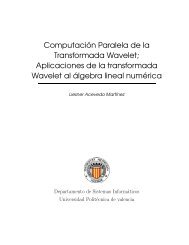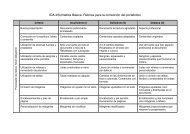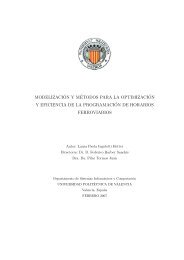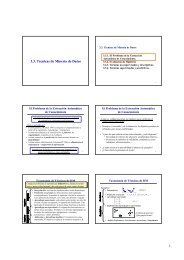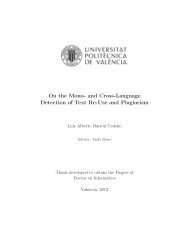desarrollo de sistemas de realidad virtual y aumentada para la ...
desarrollo de sistemas de realidad virtual y aumentada para la ...
desarrollo de sistemas de realidad virtual y aumentada para la ...
Create successful ePaper yourself
Turn your PDF publications into a flip-book with our unique Google optimized e-Paper software.
Respecto a <strong>la</strong> corre<strong>la</strong>ción entre presencia y ansiedad, al igual que en el estudio<br />
anterior, se consi<strong>de</strong>ró interesante analizar rigurosamente dicha re<strong>la</strong>ción. Para ello, al<br />
igual que en el estudio anterior, se utilizó <strong>la</strong> corre<strong>la</strong>ción <strong>de</strong> Pearson. El objetivo <strong>de</strong> este<br />
análisis es <strong>de</strong>terminar si <strong>la</strong> corre<strong>la</strong>ción <strong>de</strong> estas dos variables (en cada re<strong>la</strong>ción<br />
<strong>de</strong>finida) es significativa. La forma <strong>de</strong> proce<strong>de</strong>r se explicó con más <strong>de</strong>talle en el<br />
apartado 4.7.<br />
En primer lugar, es necesario <strong>de</strong>finir <strong>la</strong>s re<strong>la</strong>ciones entre <strong>la</strong>s cuestiones <strong>para</strong><br />
medir el nivel <strong>de</strong> presencia y los instantes en los que se mi<strong>de</strong> el nivel <strong>de</strong> ansiedad,<br />
<strong>para</strong> así po<strong>de</strong>r estudiar su corre<strong>la</strong>ción. Observando el cuestionario <strong>de</strong> presencia<br />
utilizado, que se encuentra en los anexos, y los instantes en los que se pregunta por el<br />
nivel <strong>de</strong> ansiedad, <strong>la</strong>s posibles re<strong>la</strong>ciones podrían quedar <strong>de</strong>finidas como:<br />
a) NA2-Q2<br />
b) NA3-Q2<br />
c) NA4-Q3<br />
d) NA2-Q8<br />
e) NA3-Q8<br />
f) NA4-Q9<br />
Una vez <strong>de</strong>finidas estas re<strong>la</strong>ciones se proce<strong>de</strong> a realizar el análisis <strong>de</strong> <strong>la</strong><br />
corre<strong>la</strong>ción <strong>de</strong> Pearson, tal y como se <strong>de</strong>scribió en el apartado 4.7, consi<strong>de</strong>rando en<br />
primer lugar toda <strong>la</strong> muestra (25 usuarios). Los resultados se presentan en <strong>la</strong> tab<strong>la</strong> 28.<br />
CAVE HMD<br />
rxy t α rxy t α<br />
NA2-Q2 0.375 1.94 0.1 0.390 2.03 0.1*<br />
NA3-Q2 0.515 2.88 0.01* 0.301 1.51 0.2<br />
NA4-Q3 0.314 1.59 0.2* 0.275 1.37 0.2<br />
NA2-Q8 0.344 1.76 0.1 0.404 2.12 0.05*<br />
NA3-Q8 0.477 2.60 0.05* 0.348 1.78 0.1<br />
NA4-Q9 -0.014 0.07 - 0.656 4.17 0.001*<br />
Tab<strong>la</strong> 28: Resultados <strong>de</strong>l análisis <strong>de</strong> <strong>la</strong> re<strong>la</strong>ción entre presencia y ansiedad. El asterisco al <strong>la</strong>do <strong>de</strong><br />
algunos valores <strong>de</strong> α indica que éstos correspon<strong>de</strong>n a una corre<strong>la</strong>ción más significativa que <strong>la</strong> obtenida en<br />
el otro sistema<br />
A <strong>la</strong> vista <strong>de</strong> esta tab<strong>la</strong> se pue<strong>de</strong> afirmar que <strong>la</strong>s variables presencia y ansiedad<br />
están re<strong>la</strong>cionadas (salvo un caso), con valores <strong>de</strong> α osci<strong>la</strong>ndo entre 0.2 (mínimo) y<br />
0.001 (máximo), por lo que el riesgo <strong>de</strong> equivocarse al rechazar <strong>la</strong> hipótesis nu<strong>la</strong>, es<br />
137<br />
Desarrollo <strong>de</strong> <strong>sistemas</strong> <strong>de</strong> Realidad Virtual y Aumentada <strong>para</strong> el tratamiento <strong>de</strong> <strong>la</strong> acrofobia. Estudios …



